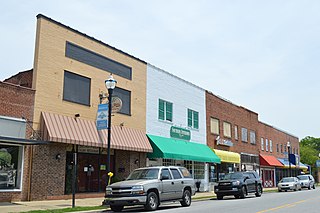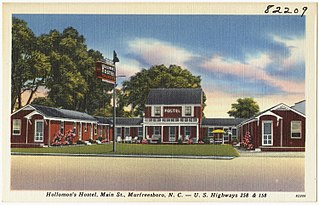Jesse Johnson Yeates was a Democratic U.S. Congressman from North Carolina between 1875 and 1881.

The Zachary-Tolbert House, also known as the Mordecai Zachary House, is a restored pre-American Civil War house located at Cashiers, Jackson County, North Carolina. The house was built between 1850 and 1852, and is a two-story, five bay Greek Revival style frame dwelling. It has a low hipped roof and central front, two-story, portico. A frame two-room kitchen was added to the rear elevation and was connected to the house by a covered breezeway in the 1920s.
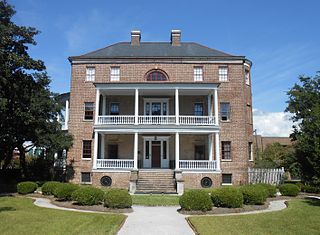
The Joseph Manigault House is a historic house museum at 350 Meeting Street in Charleston, South Carolina that is owned and operated by the Charleston Museum. Built in 1803, it was designed by Gabriel Manigault to be the home of his brother, and is nationally significant as a well-executed and preserved example of Adam style architecture. It was declared a National Historic Landmark in 1973.

The Edgar Allan "E. A." Poe House is a historic home located at Fayetteville, Cumberland County, North Carolina.

The Greensboro History Museum, consisting of the former First Presbyterian Church of Greensboro and Smith Memorial Building, is a historic museum building located at 130 Summit Ave. in Greensboro, Guilford County, North Carolina. The former Presbyterian church was built in 1892, and is a Romanesque Revival style brick building with a cross gable roof and tower. The semi-circular, 11 bay, Smith Memorial Building was built in 1903. It features four octagonal sides and a tower. The memorial building was designed by the architect Charles Christian Hook (1870-1938). The church and memorial building were connected and the older structures modified and renovated in 1938. Also located on the property is the First Presbyterian Church cemetery, established in 1831, after the first church was built on land that was donated by Jesse H. Lindsay. The church vacated the property in 1929, and in 1937-1938 it was renovated and enlarged as the Richardson Civic Center and donated to the city of Greensboro. It subsequently housed the Greensboro Public Library, the Greensboro Historical Museum, and the Greensboro Art Center. The historic building functions as one part of the current, larger Greenboro History Museum.
Albert Gamaliel Jones was a notable "house carpenter" from Warren County, North Carolina. He built "distinctive" Greek Revival plantation houses and college buildings.

The House in the Horseshoe, also known as the Alston House, is a historic house in Carthage, North Carolina in Moore County, and a historic site managed by the North Carolina Department of Natural and Cultural Resources' Historic Sites division. The home, built in 1772 by Philip Alston, was the site of a battle between loyalists under the command of David Fanning and patriot militiamen under Alston's command on either July 29 or August 5, 1781. The battle ended with Alston's surrender to Fanning, in which Alston's wife negotiated the terms with the loyalists.

Melrose is a historic home located in the Murfreesboro Historic District at Murfreesboro, Hertford County, North Carolina. It was built about 1805, as a two-story, Federal style brick dwelling with a gable roof and interior end chimneys. Two-story, two bay, Greek Revival style wings were added in the mid-19th century. It is seven bays wide and features a tetrastyle portico supported by Ionic order columns and a Second story semi-circular balcony. It was built by Congressman William H. Murfree, son of Hardy Murfree.
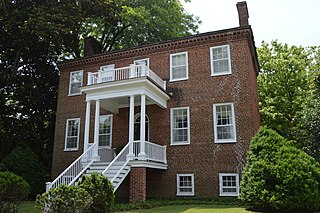
Myrick House is a historic home located in the Murfreesboro Historic District at Murfreesboro, Hertford County, North Carolina. It was built about 1805, and is a two-story, five bay, Federal style brick dwelling with a low hip roof and interior end chimneys. The front facade features a one-story hip roofed front porch supported by four fluted columns. It has a one-story, frame rear wing. It was built by James Morgan, a prominent local merchant.

John Wheeler House is a historic home located in the Murfreesboro Historic District at Murfreesboro, Hertford County, North Carolina. It was built about 1805, and is a two-story, three bay, vernacular Federal style brick dwelling with a central passage plan. The front facade features a later two-story pedimented portico. It was the birthplace of John H. Wheeler (1806-1882) and later home of Congressman Jesse Johnson Yeates (1829-1892).

Freeman House, also known as The Hertford Academy, is a historic school building located in the Murfreesboro Historic District at Murfreesboro, Hertford County, North Carolina. It was built about 1810, and is a two-story, Federal style brick building with a hip roof and central passage plan. It is considered the birthplace of Chowan University.

The Columns, also known as the McDowell Columns Building, is a historic school building located at Murfreesboro, Hertford County, North Carolina. It was built about 1852, and is a three-story, Greek Revival style stuccoed brick building with a low hip roof and octagonal belvedere. The front facade features a massive portico supported by eight Doric order columns. It was built to house the Chowan Baptist Female Institute, later Chowan University. The building houses the school's administrative offices.

Myrick–Yeates–Vaughan House, also known as the Yeates–Vaughan House, Uriah Vaughan Jr. House, and Sarah Vaughan House, was a historic home located at Murfreesboro, Hertford County, North Carolina. The "T"-plan house consisted of an earlier 1 1/2-story Federal style rear section with a two-story Greek Revival style front section. The Greek Revival was built between 1851 and 1855. It was owned by Congressman Jesse Johnson Yeates (1829-1892) during the 1870s. The house has been demolished.

Cowper-Thompson House, also known as the William Cowper House and Reverend Thompson House, is a historic home located at Murfreesboro, Hertford County, North Carolina. It was built about 1790, and is a 1 1/2-story, five bay, transitional Georgian / Federal style frame dwelling with a center-hall plan. It is sheathed in weatherboard and is connected to the original kitchen dependency by a new kitchen addition. The house was restored in 1978-1980.

David A. Barnes House is a historic home located at Murfreesboro, Hertford County, North Carolina. It was built in 1875, and is a two-story, three bay, Italianate style frame dwelling with a hip-roof. It is sheathed in weatherboard and features a one-story, hip-roof porch supported by four square-paneled posts with sawn brackets. Also on the property are the contributing five-hole privy, a kitchen house, and two miscellaneous outbuildings.

Railroad House is a historic home located at Sanford, Lee County, North Carolina. It was built in 1872, and is a 1 1/2-story, three bay, board-and-batten, Gothic Revival style frame cottage. The gable roof has wide overhanging eaves and "rafter brackets." It has a one-story rear wing, a single central interior chimney in the main block, and an exterior end chimney at the rear of the wing. It was built by the Raleigh and Augusta Air Line Railroad for the depot agent. The house was moved to its present site in October 1962, across the street from its original location. The building is operated by the Railroad House Historical Association as a museum.
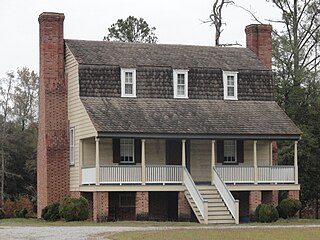
Francis Parker House, also known as Parker's Big Run or High House, is a historic home located near Murfreesboro, Northampton County, North Carolina. It was built about 1785, and is a 1 1/2-story, hall and parlor plan, Georgian style frame dwelling with a one-story rear wing. It has a gambrel roof, is sheathed in weatherboard, sits on a raised brick basement, and rebuilt massive paved double-shoulder exterior end chimneys. The house was moves to its present location in 1976. The contributing Vaughan house and pyramidal-roof frame dairy, were also moved to the site.

